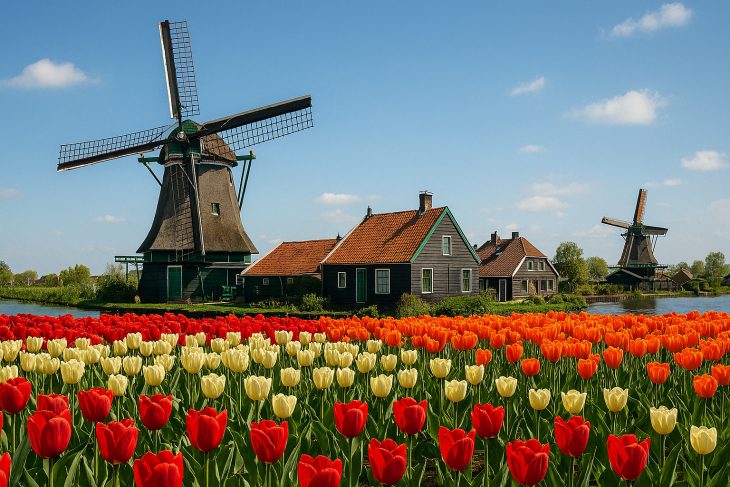
Holland, often used interchangeably with the Netherlands, technically refers to just two provinces—North and South Holland. Yet the name has come to represent much of the nation’s global identity. From windmills and canals to artistic legends and quirky traditions, Holland packs a lot into a small area. This list breaks down 30 facts across culture, geography, food, innovation, and more to give you a sharper look at what defines this fascinating region.
Geography and Landscape
Holland’s landscape is flat, engineered, and iconic, shaped by both nature and necessity.
- A quarter of the country is below sea level.
Ingenious water management keeps the land dry and usable. - Holland is part of the Netherlands, not the whole country.
Only North and South Holland are officially “Holland.” - The Dutch created land from the sea.
Through polders and dikes, they expanded their territory. - Windmills are more than just symbols.
They pump water, grind grain, and once powered industry. - There are over 4,000 km of navigable canals.
These are used for both leisure and transportation.
Culture and Traditions
Holland’s customs mix stoic pragmatism with colorful celebrations.
- The Dutch celebrate King’s Day with orange everything.
Streets turn into festivals honoring the monarch. - Sinterklaas arrives by boat from Spain.
A pre-Christmas tradition full of sweets and parades. - Tolerance is a cultural pillar.
The country has long supported personal freedoms. - Bicycles outnumber people.
Around 23 million bikes exist for 17 million residents. - Wooden shoes were once everyday footwear.
Clogs, or klompen, are still worn in rural areas.
Art and Design
Holland has a long-standing relationship with artistry and innovation.
- Vincent van Gogh was Dutch.
His bold colors and brushwork changed art history. - The Dutch Golden Age birthed masters like Rembrandt.
Their works still dominate museums today. - Mondrian pioneered abstract modernism.
His grids and primary colors came from Dutch soil. - Delftware is blue-and-white ceramic art.
It remains a national symbol and popular souvenir. - The Rijksmuseum houses over 1 million objects.
It’s one of the world’s top art institutions.
Food and Drink
Local food may seem simple, but it’s steeped in tradition.
- Stroopwafels are caramel-filled cookie waffles.
Best eaten warm over a hot cup of coffee. - Raw herring is eaten with onions.
Locals eat it by holding it by the tail and tilting their heads back. - Dutch cheese markets are centuries old.
Gouda and Edam are exported around the globe. - Bitterballen are deep-fried meat snacks.
A staple in bars and at social events. - Gin originated here as jenever.
British gin evolved from this Dutch spirit.
Economy and Innovation
A small country with a big economic footprint.
- Holland is one of the world’s top exporters of food.
Despite its size, it’s a global agricultural power. - The Port of Rotterdam is Europe’s largest.
It’s a central hub for global shipping. - Dutch design is minimal and functional.
Architecture, fashion, and home goods reflect this aesthetic. - Philips started in the Netherlands.
It grew from light bulbs to healthcare tech. - The Dutch founded the world’s first stock exchange.
This took place in Amsterdam in the 1600s.
Unique Facts
Some facts simply don’t fit anywhere else — and that’s what makes them memorable.
- Holland was one of the first to legalize same-sex marriage.
It did so in 2001, ahead of most of the world. - Tulip mania was an actual economic bubble.
In the 1600s, rare tulip bulbs sold for more than houses. - The Netherlands has no mandatory tipping culture.
Service charges are usually included in the bill. - Dune preservation is a national priority.
Coastal dunes protect the inland areas from flooding. - Dutch is the official language, not “Hollandese.”
English is widely spoken, especially in cities.
Final Take: Holland Beyond Amsterdam
While Amsterdam often grabs the spotlight, there’s much more to Holland than its famous capital. The region reflects centuries of ingenuity, from water control systems to revolutionary art and design. Its culture blends tradition with modern sensibilities, making it both historic and progressive. Whether it’s cycling along canals, tasting raw herring, or admiring a Rembrandt, Holland offers experiences that go far beyond postcard clichés. These 30 facts just scratch the surface of a region that continues to shape global culture in quiet but remarkable ways.
Was this page helpful?
Our commitment to delivering trustworthy and engaging content is at the heart of what we do. Each fact on our site is contributed by real users like you, bringing a wealth of diverse insights and information. To ensure the highest standards of accuracy and reliability, our dedicated editors meticulously review each submission. This process guarantees that the facts we share are not only fascinating but also credible. Trust in our commitment to quality and authenticity as you explore and learn with us.
